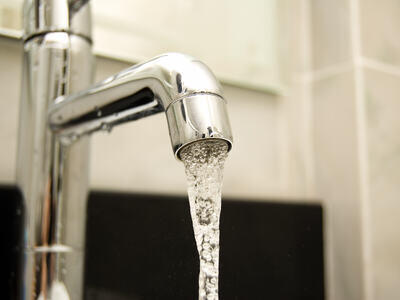Denne uken starter vi med spyling av vannrørene. Dette betyr at man kan oppleve både lavt trykk og misfarging av vann. Skru ut silen i kranen og la vannet renne til det blir rent.
Vannet blir testet etter hvert som det utføres tiltak, og vi holder innbyggerne oppdatert ved ny informasjon.
Legionella
Smittevernoverlege Ole Tveiten ved Longyearbyen sykehus sa til Svalbardposten at risikoen er lav for at noen skal bli smittet av legionella.
– Dette er en sykdom med veldig liten risiko for å bli smittet, det er vanligvis sårbare grupper med nedsatt immunforsvar og eldre som kan bli rammet, sier Tveiten til avisen.
Folkehelseinstituttet har laget en legionella veileder som finnes her
Her finner man også råd til tiltak man kan gjøre hjemme
Spyling av rør
Det er en stor operasjon som skal skje denne uken med spyling av alle rør. Spylingen starter mandag kveld, det overflødige vannet vil gå ut på tundraen, og dette vil synes i byen.
Spylingen starter klokken 22:00 . I første omgang så spyler vi husrekkene på østsiden av elva. Vann fra spylingen vil gå ut på tundraen rundt om i boligområdene. Så hvis dere ser mye vann er dette som det skal være.
Vi vet ennå ikke hvor lenge rørene må spyles, effekten av arbeidet vurderes kontinuerlig.
Klor
Som et ledd i legionella bekjempelsen vil det tilsettes klor i drikkevannet frem til vi kan friskmelde vannet. Mange norske vannverk bruker klor til desinfeksjon av drikkevannet. I Norge har vi forholdsvis rent råvann og tilsetter mindre klor til vannet enn i mange andre land. De mengder klor som brukes i norske vannverk, er ikke helseskadelige, står det på nettsiden til Norskvann.no
Nedvask av høydebasseng
Det vil bli gjennomført nedvask av høydebassenget. Kontrakt er inngått. Dette arbeidet vil bli startet så fort vi har fått opp utstyret som trengs for gjennomføring.
Fakta:
- Den 23. mars ble det funnet legionellabakterier i vannprøver tatt ved Avinor.
- 15.april ble det tatt en rutinemessig oppfølgingsprøve på Miljøstasjonen, der det senere ble påvist legionella. https://www.lokalstyre.no/legionellabakterier-i-vannproever-legionella-bacteria-found-in-water-samples.6664853-321755.html
- Den 24. april ble det tatt ti ulike vannprøver på strategiske steder i Longyearbyen for å finne smittekilden til legionellabakteriene: https://www.lokalstyre.no/vannproever-sendt-til-analyse-water-samples-sent-for-analysis.6664854-321755.html
- 2. mai ble det påvist legionellabakterier i samtlige ti vannprøver som ble sendt inn til analyse sist uke – LL setter inn tiltak: https://www.lokalstyre.no/legionellabakterier-paavist-i-vannproever-legionella-bacteria-detected-in-water-samples.6666100-321755.html
- 3.mai ble det tatt 12 ulike vannprøver på de samme stedene som sist, i tillegg til på inntak fra Isdammen og uttak fra Isdammen.
- 6. mai, melding om vedlikehold på vannledningene: https://www.lokalstyre.no/vedlikehold-paa-vannledninger-i-byen.6666390-321755.html
//
We are taking several measures after Legionella bacteria were detected in water samples. This week, we will start flushing the water pipes. This means that you may experience both low pressure and discoloration of the water. Remove the filter in the tap and let the water run until it runs clear. The water will be tested as the measures are carried out, and we will keep the residents updated with new information.
Legionella
Infectious disease doctor Ole Tveiten at Longyearbyen Hospital told Svalbardposten that the risk of anyone getting infected with Legionella is low.
"This is a disease with a very small risk of infection; it is usually vulnerable groups with weakened immune systems and the elderly who may be affected," Tveiten told the newspaper.
The Norwegian Institute of Public Health has created a legionella guide, which can be found here. Here you will also find advice on measures you can take at home.
Flushing of pipes
There is a major operation planned for this week with flushing of all pipes. Flushing will start Monday evening, and the excess water will flow out onto the tundra, which will be noticeable in the town. Flushing will start at 22:00. Initially, we will flush the rows of houses on the east side of the river. Water from flushing will flow onto the tundra in residential areas. So if you see a lot of water, this is as it should be. We still do not know how long the pipes need to be flushed; the effectiveness of the work is continuously assessed.
Chlorine
As part of the Legionella control, chlorine will be added to the drinking water until we can declare the water safe. Many Norwegian waterworks use chlorine for disinfection of drinking water. In Norway, we have relatively clean raw water and add less chlorine to the water than in many other countries. The amounts of chlorine used in Norwegian waterworks are not harmful to health, according to the website Norskvann.no.
Cleaning of elevated reservoir
Cleaning of the elevated reservoir will be carried out. A contract has been made. This work will start as soon as we have received the necessary equipment for implementation.
Facts:
- On March 23, Legionella bacteria were found in water samples taken at Avinor.
- On April 15, a routine follow-up sample was taken at the Environmental Station, where Legionella was later detected.
- On April 24, ten different water samples were taken at strategic locations in Longyearbyen to find the source of Legionella bacteria.
- On May 2, Legionella bacteria were detected in all ten water samples submitted for analysis last week – measures are being taken.
- On May 3, twelve different water samples were taken at the same locations as before, in addition to intake and outlet samples from Isdammen.
- On May 6, notification of maintenance on water pipes.

